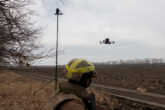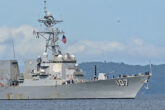October 23, 2018
The INF Treaty hamstrings the U.S. Trump is right to leave it.
The Trump administration has announced that it plans to withdraw from the Intermediate-range Nuclear Forces (INF) Treaty of 1987. This treaty banned the United States and Russia from possessing any ground-launched ballistic and cruise missile systems with ranges between 500 and 5,500 kilometers (300 to 3,400 miles). The administration’s decision is sure to elicit a cacophony of criticism, but the truth is that the United States should no longer tolerate the INF status quo. The reasons basically boil down to two: Russia appears unwilling to give up the systems that violate INF (meaning INF is essentially a dead letter), and, more important, the United States no longer benefits from a ban on ground-based intermediate-range systems — but because of China, not Russia.
This is not to downplay the importance of INF. The treaty played a major role in enabling and locking in the diminution of tensions that ended the Cold War. In particular, it eliminated all of the Soviet Union’s SS-20 intermediate-range missiles, which posed a particularly pressing threat to NATO’s defenses in the 1970s and 1980s.
This was all well and to the good. But today is another day. Russia is no longer abiding by the treaty, and Moscow gives no indication of being open to coming back into compliance. The treaty has therefore become a one-way arrangement: The United States is abiding by it, but Russia is not.
This would not by itself be a compelling argument for withdrawal, because the United States does not require INF-restricted systems for effective deterrence and defense in Europe, and staying in the treaty highlights Russia’s perfidy. The United States and its NATO allies must take steps to improve their defense posture against Russia, but noncompliant systems are not necessary to do this. Since the Russian threat is more modest in scale than the Soviet one was, the United States could meet the need by investing in better penetrating strike aircraft and munitions, sea- and undersea-launched missiles, improved ground-based fires, more resilient basing, better logistics, more effective and affordable air and missile defense, and the like.
Read the full article in The Washington Post.
More from CNAS
-
Drones: Who Is Making the New Weapons of War?
From Ukraine and Russia to Gaza and Sudan, drones have become a key weapon of war. Which companies are making them, and profiting from this rapidly expanding but controversial...
By Stacie Pettyjohn
-
Who Will Lead on Military AI, the Government or Industry?
The military is going to use artificial intelligence. But while planners in the government may have an idea of the best way forward, can they truly lead, or will industry stee...
By Josh Wallin
-
What Trump Really Wants with Venezuela
The Trump administration says it’s targeting narco-traffickers. But critics at home and abroad have decried the attacks and challenged their legal basis. Meanwhile, President ...
By Becca Wasser
-
Defense / Technology & National Security
What to Expect from Military AI in 2030As the US military races to harness artificial intelligence, experts say the biggest AI breakthroughs may not come from “killer robots” or autonomous war machines, but from al...
By Josh Wallin




